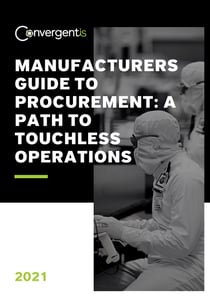In a trend towards touchless technology, direct procurement is one area that, when digitalized, can drive a major return on investment (ROI). This digitalization movement will include both the backend infrastructure and tools that reduce the number of human touches needed and help streamline the overall procurement process by reducing or eliminating steps where possible. In this context, the term “touchless” can then refer to data being electronic rather than recorded by paper or on a spreadsheet. More importantly, it also means that if things go smoothly, you don’t need a human to make the approval; your system should be able to make the approval on behalf of your team.
By automating invoice processing, your team will handle growing volumes of invoices with fewer staff and reduce invoice errors and exceptions. This is because an end-to-end digital procurement process is known to have lower operational costs when compared to the costs incurred when scanning or using Optical Character Recognition (OCR) equipment. Here is how your business can start your path towards touchless procurement for manufacturers.
Paving the Way Towards Digitalization
There are multiple benefits of a touchless procurement system. First, by adopting touchless technology, procurement departments can significantly reduce human errors and rework through the use of process automation. By standardizing and digitizing the purchase request from the beginning and making heavy use of flipping capability, such as PR-to-PO flip or PO-to-Invoice flip, your team will enable a significant jump in procurement process efficiency. For example, according to SAP Ariba, invoice automation has resulted in a 2.9x higher number of invoices processed per FTE. Likewise, Coupa claims that nearly 23,000 invoices can be processed per FTE annually. Instead of human intervention, touchless systems rely on a set of business rules and automation to govern the automatic acceptance criteria for POs, Goods Received, Invoices, etc. This results in benefits such as fewer errors and overall better invoice compliance. Further, since invoices can be easily paid on time, suppliers will also be better positioned to take advantage of early-payment discounts.
Conversely, when businesses are slow to approve invoices and issue payments, suppliers may get frustrated, resulting in damaged relationships.
Streamlining the Procurement Process
Becoming digital is largely dependent on the ability to create POs directly from purchase requisitions and contracts (PR-to-PO or Contract-to-PO flip), as well as invoices from purchase orders (PO-flip) and service entry sheets (SES-flip). For those unfamiliar, a PO-flip is a process that allows the information on a Purchase Order, such as milestones and materials, to be migrated (or flipped) directly from the PO to the Invoice to quickly produce the electronic invoice document. Since the same information is on the PO and the Invoice, the information will match automatically.
In this manner, humans will be used only for value-added activities rather than tedious or repetitive tasks.
Only if the values between the contract, purchase requisition or purchase order don’t match are the documents escalated to a human approver. Although market estimates vary across the size of the company and the industry they operate in, most procurement experts suggest only 20% to 30% of all invoices present exceptions, leaving 70%-80% of invoices to be managed by automated approvals.
It is important to note that while many businesses don’t process paper invoices, they aren’t truly achieving e-invoicing. Consider that if your suppliers send you a PDF copy of an invoice over email or your team scans a paper invoice, your team is still processing “digital” versions of a piece of paper. However, scanning paper invoices oftentimes results in high levels of error when attempting to convert the PDF to structured data. The difference is that an electronic document using a standard encoding, such as cXML, created through ERP software, such as SAP, contains structured content from the beginning that can be readily understood by a machine and processed without any human intervention.
Finding a Solution That Works
Businesses may only take advantage of the management by exception philosophy if they are willing to adopt a fully automated procurement solution. This might be a challenge for businesses that have customized certain parts of the process or have continued to add many point solutions. The first step will be to learn how users on your team actually work. Only then will you implement a solution that everyone will use, and that can handle every type of document in the procurement process.
Therefore, taking advantage of practices such as Design Thinking can help to pinpoint the major areas of frustration in your team’s current workflows. By mapping out current processes, our team can help ensure any new solutions deployed will simplify your team's day-to-day work life.
It is also important to consider which solutions will cover all categories of procurement spend, such as direct and indirect. Incorporating all types of spend and considering the end-to-end solution process is necessary since without what many refer to as “the holy trinity of procure to pay” (purchase orders, goods receipts and invoices), your team will not be able to achieve the same level of efficiency. This would be a minimum requirement to take advantage of higher-level capabilities, such as data analytics, machine learning or artificial intelligence (AI) properties.
ConvergentIS specializes in BTP applications across many procurement use cases and offers several packages covering the complete end-to-end process. To learn more about what this looks like in your business, we encourage you to download our complete guide for manufacturers.


